Are you remarketing to people with Facebook or Google?
Did you know you can do the same thing with Twitter?
Whether you run campaigns for a client or your own business, you want to get the greatest benefit for your spend. Remarketing to your audience helps you do that.
In this article I'll explain how Twitter tailored audience targeting works and how to find the right users for your targeted campaign.
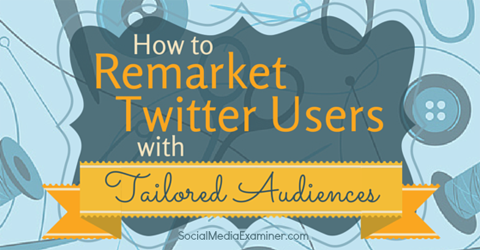
Why Twitter Tailored Audiences?
Twitter tailored audiences are the equivalent of Facebook's custom audiences. This feature allows you to target your ads based on email addresses, Twitter handles, user IDs, mobile app IDs and phone numbers.
This option makes the platform much stronger. In the past, advertisers were only able to target by keyword or interests, or use TV-based targeting. All of these are useful, but since you couldn't combine them, it made for slightly broader targeting.
While tailored audiences are great for targeting people you already know, such as your customers or newsletter list, the real power comes from targeting new interactions with very specific audiences.
The key to success: collect data to create the right tailored audience and then market to them.
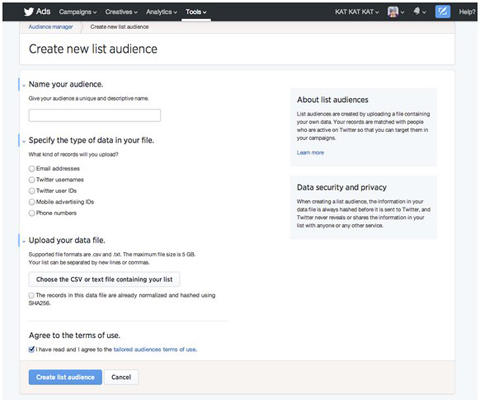
Let's say you run social media for a fashion brand. They want to run a Twitter campaign through a sponsored tweet to raise the awareness of their products for buyers for big stores. Until now, in hopes of reaching buyers, you'd run ads focusing on people who follow topical industry accounts or who talk about certain keywords.
With targeted audiences, you identify the specific people you need to reach using multiple factors (not just keywords). Do your homework, create a list or lists of ideal users and write appropriate messaging for each segment.
Here are the steps to take to seek out and reach the right Twitter users through tailored audience targeting.
#1: Find Users to Target
Seek out Twitter users who fit exactly the type of people you want to target.
Get World-Class Marketing Training — All Year Long!
Are you facing doubt, uncertainty, or overwhelm? The Social Media Marketing Society can help.
Each month, you’ll receive training from trusted marketing experts, covering everything from AI to organic social marketing. When you join, you’ll also get immediate access to:
- A library of 100+ marketing trainings
- A community of like-minded marketers
- Monthly online community meetups
- Relevant news and trends updates
Use a tool like Followerwonk to search. It'll pick up location and keywords that are in users' Twitter bios.
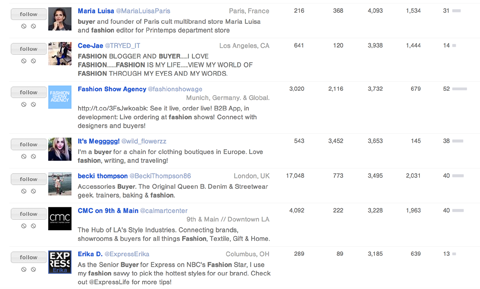
This step can be time-consuming. Try different search variations and filter out people who don't fit your profile. The more high-quality users you find at this stage, the better your overall results will be.
Export your users from Followerwonk into a spreadsheet. This will give you the data you need in a structured format. (You need a pro account to export, but you can do a 30-day free trial to check it out.)
If you've discovered enough quality users, jump over to step #4 and use the exported Twitter handles as a target audience. If you want more data, then move on to step #2.
#2: Expand Your Target List
Take your initial list of targeted users, and research who follows these accounts. On Twitter, it's natural that people with similar interests and career paths follow each other, so you may find the type of people you're looking for this way.
Get a free Twitter follower report from Simply Measured or explore the tools on Socialbakers to find who is following these users.

Discover Proven Marketing Strategies and Tips
Want to go even deeper with your marketing? Check out the Social Media Marketing Podcast! Publishing weekly since 2012, the Social Media Marketing Podcast helps you navigate the constantly changing marketing jungle, with expert interviews from marketing pros.
But don’t let the name fool you. This show is about a lot more than just social media marketing. With over 600 episodes and millions of downloads each year, this show has been a trusted source for marketers for well over a decade.
Add the best ones to your master target audience list.
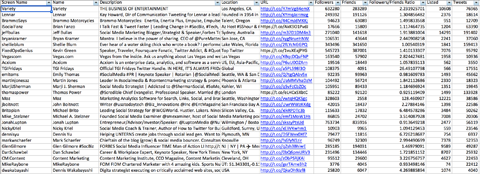
You can seek out the followers manually, but that would be very time-consuming. Go the automated route if you can.
During this search, you'll likely find that some of your target users are being followed by people and companies similar to you. For instance, going back to the fashion example, other brands that are seeking buyers. Take a deep dive into who else these people follow, as they are most likely following other relevant users.
After you discover who follows your targets, seek out those your targets follow. This could potentially add even more value to your list, especially if you find selective influencers who follow very few people.
As before, run the accounts through a tool to automate the list generation. Then manually filter to find the right accounts for your targeted list.
To help with filtering, set up a few tricks in Excel. For example, create an IF statement to help you highlight bios with the right keywords.
#3: Segment Your Lists
Once you have enough data to work with, segment your lists into whatever categories or sections make most sense. That way, you can tailor your campaign messages for each audience.
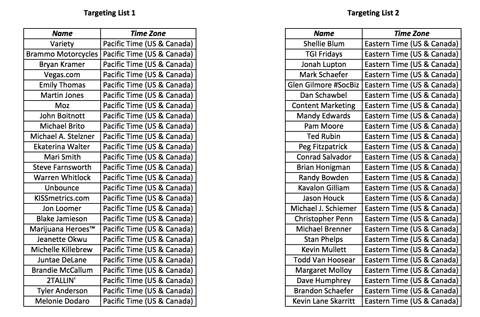
One simple way to segment is by geography. For example, if your fashion brand is looking for buyers in the United States, you may segment your accounts into two lists: East Coast and West Coast. You should be able to find the information to sort through their bio location or do some research and find where their brands are based.
This extra layer of relevance is useful, because you'll likely get a higher conversion rate when you use more targeted messaging. Something specific like, “New York fashion buyer?” rather than just “Calling all fashion buyers” can make a huge difference.
After you create your segments, come up with a few targeted messages and choose which ones to test first.
#4: Launch, Test and Tweak
Once you're satisfied with your tailored audiences and messaging, set up and launch your campaigns.
Go to tools in your Twitter advertising account and select Create New List Audience. Name your audience, check which data is in your Excel file, upload and create your campaign.
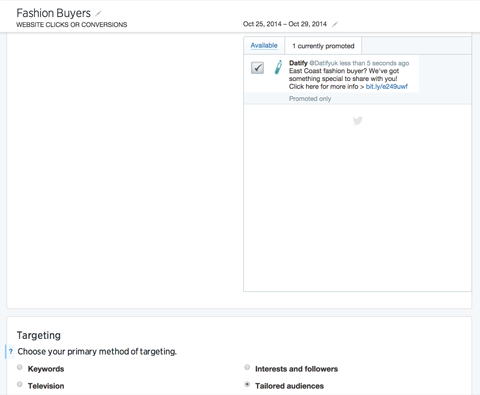
Depending on your goal (tweet engagements, website conversions, etc.), measure the performance of each audience group to see what works. Then try new things to further improve your targeting.
For example, you may find that your East Coast fashion segment doesn't perform as well as your West Coast segment. So change your messaging and/or adjust your audience: split it into additional subgroups and test those.
Advertising is a lot of research combined with a little experimentation. Test and retest until you find the most successful target audience and messaging combination.
Summary
Twitter's release of tailored audiences has improved their advertising platform considerably.
Granted, in order to get the best results, you must take the time to find the right users, create appropriate segments and write targeted messages. A little bit of hard work and creativity will help you find the right target market and get the most out of your advertising efforts.
What do you think? Have you used Twitter ads? Have you tried tailored audience targeting? What tools do you use to find the right users? Please share your thoughts and recommendations in the comments.
Attention Agency Owners, Brand Marketers, and Consultants

Introducing the Marketing Agency Show–our newest podcast designed to explore the struggles of agency marketers.
Join show host and agency owner, Brooke Sellas, as she interviews agency marketers and digs deep into their biggest challenges. Explore topics like navigating rough economic times, leveraging AI, service diversification, client acquisition, and much more.
Just pull up your favorite podcast app, search for Marketing Agency Show and start listening. Or click the button below for more information.


